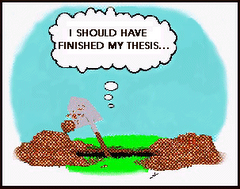[Cross-posted at Wind Farm]
Many of you know (and have commented on) the New Ethnography method of writing that I've played with before and before. It's modeled after Kathleen Stewart's Ordinary Affects. I've only sort of consulted/informed my adviser about the approach I've settled on for describing the subjects and some select scenes.
There are a number or reasons I'm drawn to this method of writing. Though I'm not particularly great at it, the method nonetheless allows me to share data-in-context. I like this. As well, these scenes provide additional points of reference that I will allude to/cite when I get to my Themes Chapter. This method also makes me feel like I'm making my study, and the write-up of my study, more transparent. I'm not sure how well it's going to work, and I've been strongly encouraged NOT to try to get all experimental with the dissertation ("Just get it done! Here is not the place to push boundaries!"). But I was struggling to find my way into this chapter and this is the method, the approach, that has created a flow for me. All other invention strategies were stalling.
Each short piece is a relatively complete scene in and of itself. More accurately, each scene is an excerpt, a moment plucked from the larger context of year in the field, that (tries to) captures some characteristics of the subjects, shows bodies in motion or bodies interacting with/engaging materials. There is no discussion of the scene or analysis of it. Part of the draw of this approach is that the reader can develop her own analysis. You see the scene. You draw develop your own impressions. I do the work of pointing out the themes and describing my coding at another point. Here is one of the excerpts. Hopefully the scene is self-explanatory.
“Unspoken words, Loud gestures”
[XX at 19 October 07 practice]:
A “shell” drill is a basketball simulation drill that teaches team defensive positioning. It’s an extremely useful teaching tool for habituating player placement for guarding opposing teams. At the beginning of the season it’s a drill that Coach uses to teach the basketball basics of team defense.
Official practice began just over a week ago and they’ve already had well over a dozen practices. The coaching staff has positioned themselves in a triangle formation on the court and around the players. AA is on the baseline. BB is on the sideline. And Coach is up top near half court. At any given moment each of them is within five-ten feet of at least four players. Their positioning allows them to intercede rapidly and within the context of the action; their positioning allows them to correct errors almost immediately as they are happening and provide instant feedback. The team is in the midst of a 4-on-4 defensive shell drill that they have repeated approximately 25 times at this point. The ball is being thrown from one side of the court to the other. The players are quickly reacting and jumping to their appropriate position. Everybody but XX, that is. Naturally slow afoot, the big man’s reaction times are consistently slower than his teammates. However, for this drill he’s not just slow; he’s out of place. The team has been bombarded with a lot of information and numerous drills, but XX is the only player who is not catching on to the principals Coach is trying to teach with this drill.
All three coaches immediately spot the error of XX’s movements. As the ball is being passed around up top, AA, who is on the baseline, takes his hands off his knees, rises from his umpire-like stance, straightens his posture and begins to move towards XX. He begins an attempt to stop the action; he’s about to instruct XX. Before AA can intercede, Coach sees AA. He throws his arms in the air and waves them – elbows locked, fingers spread, palms facing AA. At an unusually low decibel level Coach says, “Let it go. Let him go.” Coach turns his back slightly and hangs his head as he subtly shakes it back and forth. AA inches off the court. Play continues. XX remains lost in his movements. He is a walk-on player and time is precious. They finish the drill and Coach consults the practice schedule that is folded over his gym shorts. Next drill.

